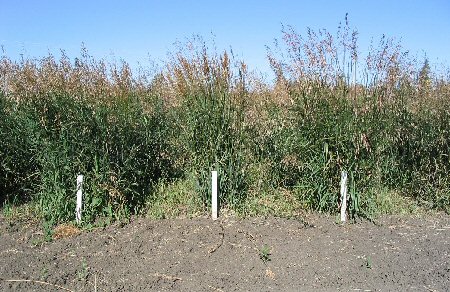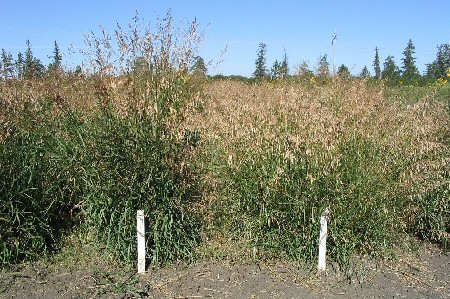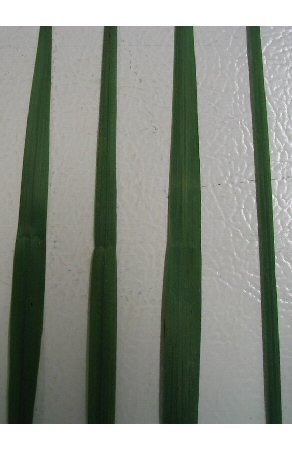Success
| Denomination: | 'Success' |
|---|---|
| Previously Proposed Denomination: | 'S9356I' |
| Botanical Name: | Bromus riparius x B. inermis |
| Applicant/Holder: |
Agriculture & Agri-Food Canada, Saskatoon Saskatoon Research Centre 107 Science Place Saskatoon, Saskatchewan S7N 0X2 Canada |
| Breeder: |
Bruce Coulman, Agriculture & Agri-Food Canada, Saskatoon, Saskatchewan |
| Agent in Canada: |
Agriculture & Agri-Food Canada Office of Intellectual Property and Commercialization c/o Shannon Whyte 107 Science Place Saskatoon, Saskatchewan S7N 0X2 Canada Tel: (204) 999-9887 |
| Application Date: | 2003-05-08(priority claimed) |
| Application Number: | 03-3665 |
| Protective direction granted: | 2003-05-08 |
| Protective direction withdrawn: | 2007-02-06 |
| Grant of Rights Date: | 2008-05-15 |
| Certificate Number: | 3203 |
Variety Description
Varieties used for comparison: 'Fleet' (Bromus riparius), 'Signal' (Bromus inermis) and 'Knowles' (Bromus riparius x Bromus inermis)
Summary: 'Success' has an erect to semi erect growth habit while it is semi erect to intermediate in 'Fleet'. The leaf attitude of 'Success' is intermediate while it is drooping in 'Fleet'. 'Success' has a shorter wider leaf than 'Fleet'. The leaf pubescence of 'Success' is sparser than 'Fleet' and 'Knowles' and denser than 'Signal'. 'Success' has higher thousand seed weight than 'Signal'.
Description:
PLANT: erect to semi-erect growth habit
STEM: open collar shape
LEAF: intermediate attitude, moderate pubescence, weak anthocyanin colouration of the sheath, ligule present, auricle absent
PANICLE: moderately open to opened shape, semi-erect to horizontal attitude, medium anthocyanin
Origin & Breeding History: In 1976 and 1977 three hybrid populations were produced by crossing plants of meadow brome (Bromus riparius) with plants of smooth brome (Bromus inermis). In 1981-1982, crosses were made between plants of S8778 (various sources) and S7133 (reduced creeping) smooth bromegrass with plants of one of the three hybrid populations, S9073, using the smooth bromegrass plants as the female parent. Hybrid progeny plants were selected and inter crossed to produce a line designated S9183. Several cycles of selection were done on S9183 for uniformity, floret fertility and vigor. In 1990, several tall plants with large seed size, good regrowth and reduced creep were selected and inter crossed to produce a line designated S9356. Between 1990 and 1995, several populations of S9356 designated S9356A-H were selected and evaluated in trials and nurseries. In 1995, 31 tall, vigorous plants showing good late fall greenness and growth were selected and poly crossed in the growth cabinet during the winter of 1995-1996. Seed was bulked from the 21 best plants based on seed yield to form S9356I syn-1. Some of this seed was planted in evaluation trials in Saskatoon, Saskatchewan and also established in a space planted isolated nursery of 1200 plants for syn-2 seed production and further selection.
Tests & Trials: Trials for 'Success' were conducted at the Agriculture & Agri-Food Canada Research Centre, in Saskatoon, Saskatchewan during the summers of 2005 and 2006. Trials which were established in 2004, consisted of a spaced plant nursery arranged in a randomized design. Plants were spaced on 1 metre centers, with 10 plants of each variety per replication. There were 10 replicates giving a total of 400 plants in the nursery.
Comparison table for 'Success' with reference varieties 'Fleet', 'Signal' and 'Knowles'
Thousand seed weight
| 'Success' | 'Fleet' | 'Signal' | 'Knowles' | |
|---|---|---|---|---|
| grams | 5.1 | 5.9 | 3.5 | 5.2 |
Click on image for larger view

Bromegrass: 'Success' (right) with reference varieties 'Signal' (left) and 'Knowles' (centre)
Click on image for larger view

Bromegrass: 'Success' (left) with reference variety 'Fleet' (right)
Click on image for larger view

Bromegrass: 'Success' (centre right) with reference varieties 'Signal' (left), 'Knowles' (centre left) and 'Fleet' (right)
- Date modified: